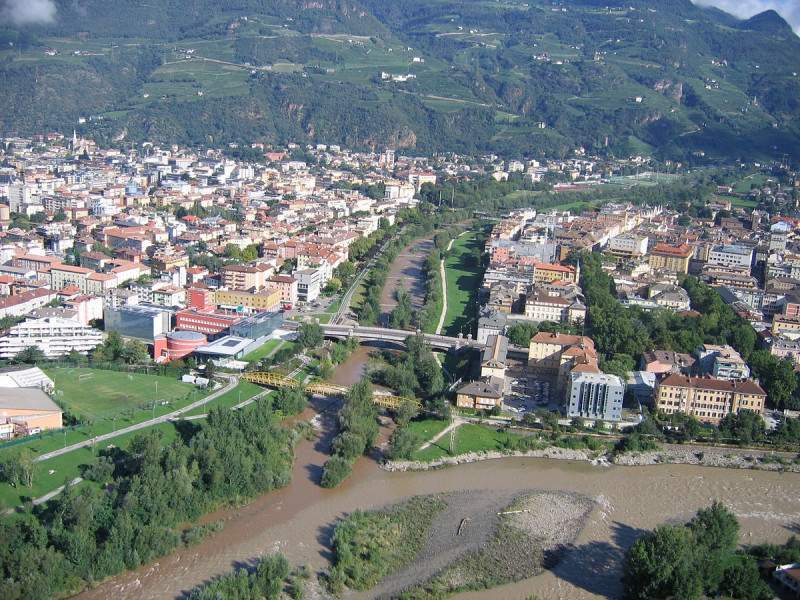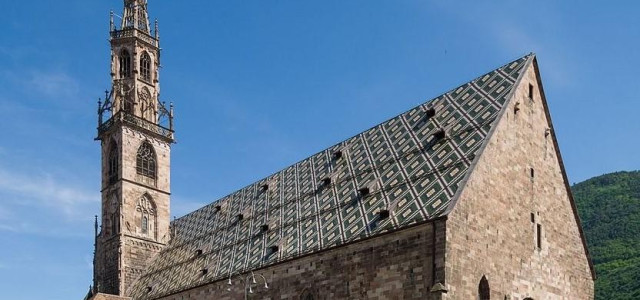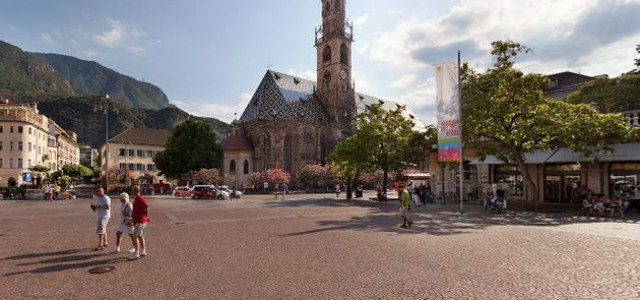Bolzano
Bolzano listen (German: Bozen, historically also Botzen; Ladin: Balsan or Bulsan; Latin: Bauzanum) is the capital city of the province of South Tyrol in northern Italy. Bolzano is the seat of the Free University of Bozen-Bolzano, where lectures and seminars are held in English, German and Italian. The city is also home to the Italian Army's Alpini High Command (COMALP) and some of its combat and support units. It is one of five mainly Italian-speaking municipalities in the Germanic province of South Tyrol. In a 2010 quality-of-life survey by the Italian newspaper Il Sole 24 Ore, Bolzano was ranked number one among 107 Italian cities on the survey's list. In the 2011 edition of the survey, Bolzano was ranked number two and came after the top-ranked Bologna. In the 2012 edition, Bolzano regained the top place as the city with the Best Quality of Life in Italy. Along with other Alpine towns in South Tyrol, Bolzano engages in the Alpine Town of the Year Association for the implementation of the Alpine Convention. The Convention aims to promote and achieve sustainable development in the Alpine Arc. Consequently, Bolzano was awarded Alpine Town of the Year 2009. History Prehistory and Roman Settlement The modern-day Bolzano was in ancient times a marshy region inhabited by the Raetian Isarci people, traditionally believed to be descendants of Etruscan refugees fleeing Italy from the invading Gauls. The Romans built a settlement after the area had been conquered in 15 BC by General Nero Claudius Drusus. The military settlement, Pons Drusi (Drusus Bridge), was named after this Roman General. During this time the area became part of the region Venetia et Histria (Regio X) of ancient Italy. In 1948, excavations of the current Cathedral led to the discovery of an ancient Christian basilica from the 4th century. Also discovered was a Roman cemetery, including the tomb of "Secundus Regontius" with Latin inscriptions dating to the 3rd century, making him the oldest known inhabitant of Bolzano. Bavarian Settlement During the gradual decline of the Roman's influence in the 7th century, Bavarian immigration took place and the first mention of a Bavarian ruler in Bolzano dated from 679. At that time, the Bavarians named the nearby villages around Bolzano Bauzanum or Bauzana. German populations have been present in the region of Tyrol since this time. Bishopric of Trent In 1027 the city of Bolzano together with the rest of the diocese was conferred upon the bishops of Trent. In the late-12th century, the Bishop of Trient founded a market town, along the Lauben-throughfare, near Bolzano. The town therefore became an important trading post on the Transalpine Augsburg-Venice route over the Brenner Pass, elevation 1,371 metres (4,498 ft) above sea level, within the Holy Roman Empire. County of Tyrol and Holy Roman Empire In 1277 Bolzano was conquered by Meinhard II, the Count of Tyrol, leading to a struggle between the Counts of Tyrol and the bishops of Trent. In 1363, the County of Tyrol fell under the influence of Habsburg Austria and the Holy Roman Empire. In 1381, Duke Leopold granted the citizens of Bolzano the privilege of a town council. This gradually eliminated the influence and power previously held by the bishops of Trent over the next few decades. In 1462, the bishops eventually resigned all their rights of jurisdiction over the town. From the 14th and 15th centuries onwards, a large market fair was organised four times per year to greet tradesmen and merchants en-route the Brenner Pass. The Mercantile Magistrate was therefore founded in 1635 by the Austrian duchess Claudia de' Medici. During every market season, two Italian and two Germanic officers, who were appointed among the local tradesmen, worked in this magistrate office. The establishment of an official trade organisation strengthened Bolzano as a cultural crossroad in the Alps. Part of Italy After the dissolution of the Holy Roman Empire in 1806, Bolzano became part of the Napoleonic Kingdom of Italy and was incorporated into the Dipartimento Alto Adige. After the Congress of Vienna (1814-15) Bolzano returned to the County of Tyrol, within the Austrian Empire and subsequently the Dual Monarchy of Austria-Hungary in 1866. The County covered both modern-day South Tyrol and the Federal States of Tyrol and East Tyrol in Austria. In 1915, the Triple Entente powers promised Italy territorial gains if she would enter the First World War on the side of the Entente instead of siding with the German Empire and Austria-Hungary. When Italy abandoned the Triple Alliance (1882), the Entente offered her territorial promises in Tyrol and Istria. This secret arrangement was confirmed in the Treaty of London (1915). No fighting took place in the County of Tyrol during the First World War. Germany and Austria-Hungary, however, lost to the Entente and signed an armistice in 1918. The transfer of South Tyrol to Italy took place in 1919. At the time of Bolzano's annexation by the Kingdom of Italy, the town was settled primarily by a German-speaking population. As of 1910, 29,000 inhabitants were German-speaking and only 1,300 Italian-speaking. In the 1920s, along with the rest of South Tyrol, Bolzano was subjected to an intensive Italianisation programme under the orders from the Fascist leader Benito Mussolini. The aim of his programme was to outnumber the local German-speaking population by tripling Bolzano's population with Italian-speaking immigrants drawn from the rest of the country. In 1927, Bolzano became the capital of the province of South Tyrol. In 1933, Adolf Hitler came to power in the Weimar Republic. There was worry among Mussolini and the Fascists that Hitler, in facilitating his extreme ideology of all ethnic Germans under one Reich, would reclaim South Tyrol from Italy. Consequently, Mussolini and Hitler secured an agreement, the Option Agreement, in 1939. Hitler would renounce his claims over South Tyrol as Germany's Lebensraum (living space). Nevertheless, those Germans who opted to stay in South Tyrol and refuse to relocate to the Third Reich would be regarded as traitors and subject to a full-scale Italianisation. Second World War During the Second World War, Bolzano was the site of the Nazi's Bolzano Transit Camp, a concentration camp for persecuted Jews and political prisoners. After 1943, heavy fighting against Nazi Germany and the Axis Powers took place in the Dolomite Alps once the Allied Powers had liberated Italy. After the War, independence movements gradually gained popularity among the Germanic population in Bolzano and South Tyrol. In the 1960s, a series of terrorist attacks and assassinations were carried out by the South Tyrolean Liberation Committee – a German secessionist movement – against Italian police, officials and infrastructure facilities (one notable incident being the Night of Fire on 12 June 1961), forcing the United Nations to intervene in the negotiations with the Italian government in Rome. After 11 years of mediation and negotiation, a resolution was reached between Austria and Italy on granting considerable self-government to South Tyrol. Euroregion Tyrol-South Tyrol-Trentino In 1996, the European Union approved of further integration of the Austrian state of Tyrol with the Germanic province of South Tyrol and Trentino (Welschtirol) in Italy. Society Linguistic distribution According to the 2011 census, 73.80% of the city's inhabitants speak Italian, 25.52% German and 0.68% Ladin as their first language. Economy The city thrives on a mix of old and new high-quality intensive agriculture (including wine, fruit, and dairy products), tourism, traditional handicraft (wood, ceramics), and advanced services. Heavy industry (machinery, automotive, and steel) installed during the 1930s has now been mostly dismantled. On the downside, the local economy is very dependent on the public sector and especially the provincial government. Bolzano is the biggest city in South Tyrol, which is an autonomous province in Northern Italy with a special statute. This statute preserves the rights of the German-speaking minority in Italy. This unique system was admired by the Dalai Lama, who visited the city on several occasions to study a possible application in Chinese-occupied Tibet. It has also been presented as role model for the successful and fair resolution of inter-ethnic conflict to other regions of the world. Climate Being located at multiple climate borders, Bolzano features a humid subtropical climate (Cfa) with hot summers and very cool winters. According to the Trewartha classification, this climate could not be really considered like a subtropical climate because of less than 8 months are at least 10 °C (50 °F), and thus would be considered like a semi-continental climate with hot summers. Some of its suburbs feature an oceanic climate (Cfb) due to some cooler summer temperatures, while mountains in the area may feature a continental climate (Dfb). Main sights Its medieval city centre, Gothic and Romanesque churches and bilingual signage give it the flavour of a city at the crossroads of Italian and Austrian cultures. This and its natural and cultural attractions make it a popular tourist destination. Among the major monuments and sights are: the Walther Square, with a statue of Walther von der Vogelweide, a German minstrel (minnesinger) the Laubengasse or Via dei Portici, a street 300 metres (980 ft) long, in the city centre with medieval carcades along its entire course, now housing countless high-street shops the South Tyrol Museum of Archaeology, which has the mummy of Ötzi the Iceman the Gothic Cathedral, started in 1184, expanded in the 14th century by architects Martin and Peter Schiche and completed in the early 16th century by Hans Lutz von Schussenried the old parish church of Gries, with an altarpiece by Michael Pacher the benedictine monastery of Muri-Gries, with baroque paintings by Martin Knoller the Chiesa dei Domenicani/Dominikanerkirche (13th century), with a series of 14th-century Gothic paintings various castles, including Castle Maretsch, Runkelstein Castle and Firmian/Sigmundskron Castle Victory Monument, a triumphal arch built on the order of Benito Mussolini in 1928, site of a permanent exhibition on the regional history in the context ot the two dictatorships of the Italian fascism and the German nazism the Museion, a museum of modern and contemporary art Messner Mountain Museum of Reinhold Messner For more historical and geographical information see South Tyrol. City districts and neighbouring communities City districts: Centro-Piani-Rencio (German: Zentrum-Bozner Boden-Rentsch) Don Bosco (German: Don Bosco-Neugries) Europa-Novacella (German: Europa-Neustift) Gries-San Quirino (German: Gries-Quirein) Oltrisarco-Aslago (German: Oberau-Haslach) Neighbouring communities are: Eppan, Karneid, Laives, Deutschnofen, Ritten, Jenesien, Terlan and Vadena. Transport Bolzano is connected to the motorway network A22-E45 to Trento and Verona and to Innsbruck (Austria) and Munich (Germany). The city is also connected to the Italian railway system. Bolzano railway station, opened in 1859, forms part of the Brenner railway (Verona–Innsbruck), which is part of the main railway route between Italy and Germany. The station is also a junction of two branch lines, to Merano and Mals. There is a 50-kilometre (31 mi) network of cycle paths, and about 30 percent of journeys in Bolzano are made by bicycle. There is a regular connection between Bolzano Airport (IATA: BZO) and Rome. Sport The town is host to an annual road running competition – the BOclassic – which features an elite men's 10K and women's 5K races. The event, first held in 1975, takes place on New Year's Eve and is broadcast live on television by Rai Sport Più. Bolzano is also the host city to the Giro delle Dolomiti annual road bike event. Local teams Football F.C. Südtirol plays in Lega Pro Prima Divisione F.C. Bolzano 1996 played 2011/12 in Eccellenza F.C. Neugries played 2011/12 in Promozione Bozner F.C. played 2011/12 in Promozione Virtus Don Bosco played 2011/12 in Promozione Handball Loacker Bozen Handball Handball A-Elite Liga Ice hockey HC Bolzano Bozen Foxes plays in Serie A1 and the EBEL League, successfully winning the EBEL title in their Debut year 2014 EV Bozen 96 plays in Serie A2 Rugby Sudtirolo Rugby Cavaliers The Cavaliers play in the Italian Serie C American Football Giants Bolzano The Giants plays in IFL (Italian Football League), the first league of the FIDAF Softball and Baseball Softball Club Dolomiti Pool 77 Adler Fistball SSV Bozen plays in the FBL (Austrian Fistball League), the first Austrian league. International relations Twin towns – Sister cities Bolzano is twinned with: Maratea, Italy Sopron, Hungary See also History of South Tyrol Italianization of South Tyrol Radio Tandem References External links Media related to Bolzano at Wikimedia Commons Bolzano City Hall Official website (in Italian and German) Bolzano Tourist Board Official website BOhisto – Bozen-Bolzano's History Online BZ '18–'45. One monument, one city, two dictatorships Bozner Nachrichten. Bolzano's historical newspaper, with issues digitised from 1894 to 1925 Bolzano travel guide from Wikivoyage






